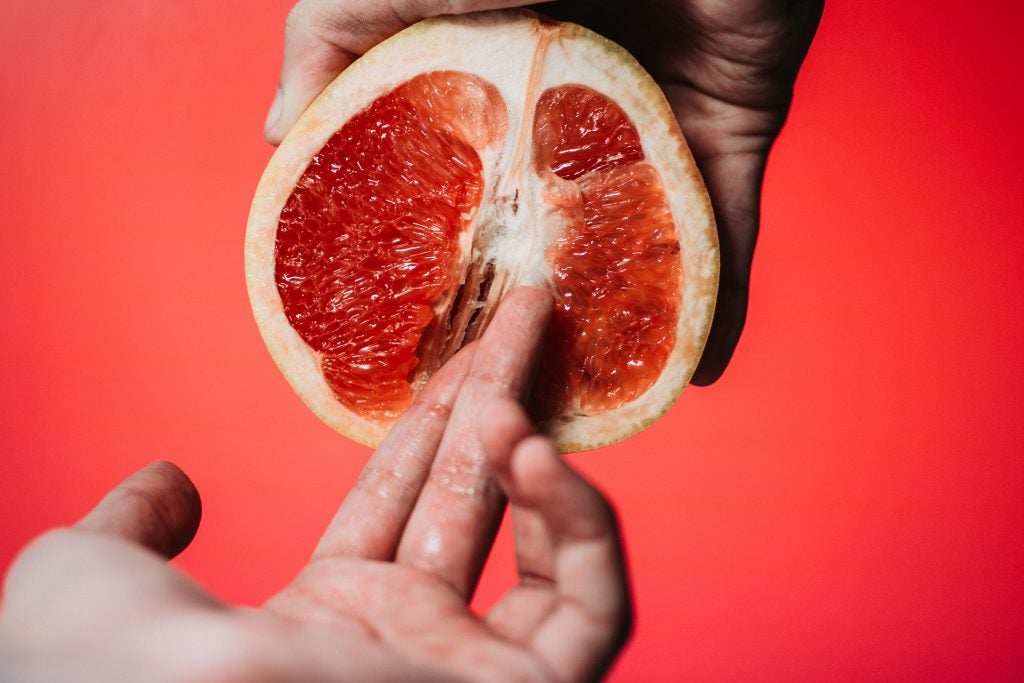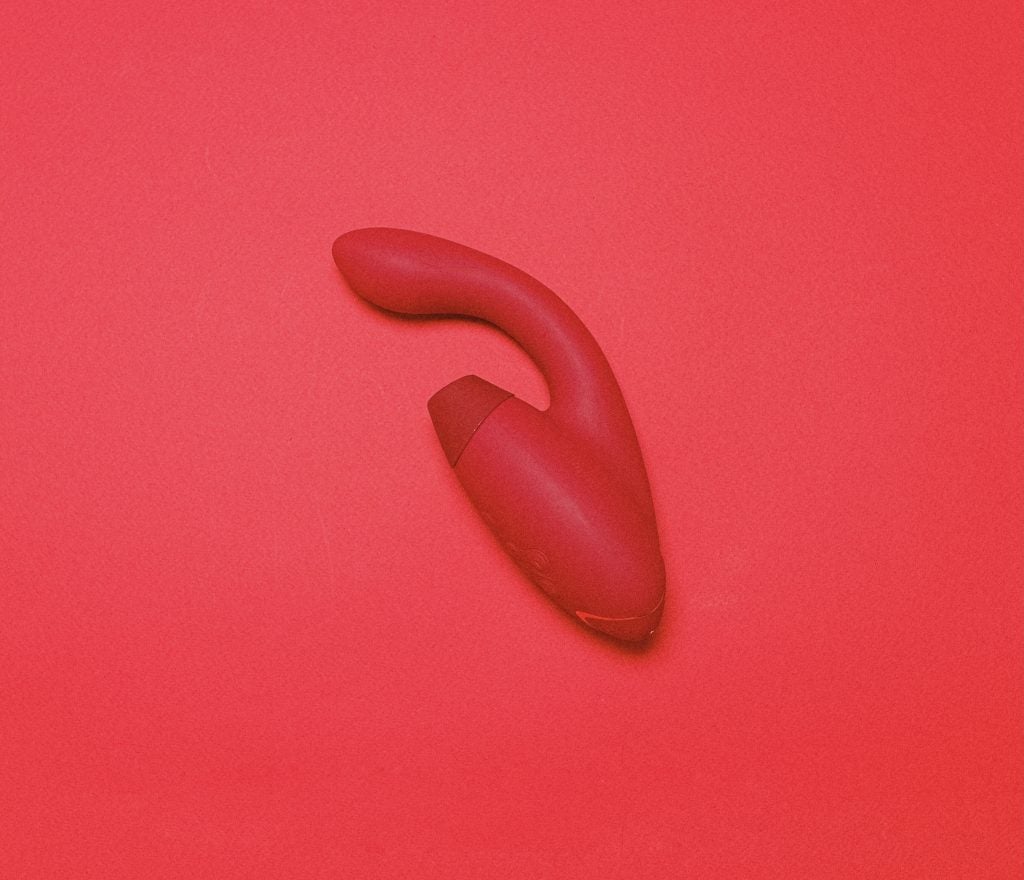
The Gräfenberg spot (G-spot), named after German gynecologist Ernst Gräfenberg, is an erogenous area in the vagina, which upon proper stimulation may cause a person to experience sexual arousal that can lead to orgasm, and in some instances ejaculation. The G-spot is located approximately two to three centimeters inside the vaginal canal on the anterior (front wall) of the vagina and changes in size in response to physical stimulation. 1 Prior to stimulation, the spot is about the size of a small bean, but once aroused it swells and gains texture, similar to the surrounding vaginal tissue. However, not all people with vulvas have been able to locate their G-spots, leading some sexologists to believe that not all vaginal canals have a G-spot.
Table of Contents
Locating the G-Spot
There are multiple ways a person can locate their G-spot. Methods such as masturbation, communication, foreplay, oral sex, manual stimulation, and penile/vaginal sex are popular methods used to reach a G-Spot orgasm. Sexologists have found that it is easiest for a person to locate their G-spot while lying on their back or squatting. After assuming an accessible position, the individual should then exert pressure on the vaginal wall closest to the navel by inserting one to two fingers into the vagina. Many individuals have reported successful stimulation of the G-spot by making rhythmic movements over the area in a “come here” motion once the fingers have been inserted. This may take some time and practice, as every individual is unique and different techniques may feel better to different people.
Stimulating the G-Spot
It is normal for some people to have a harder time stimulating the G-spot than others and for this process to become uncomfortable. In this case, it is recommended to use a lubricant, or try other techniques that may be more pleasurable. Though not every person may find their G-spot or even enjoy stimulation of the area, there are numerous strategies that individuals may use to attempt G-spot stimulation on their own or with a partner.

Masturbation
Individuals can locate their own G-spots through manual masturbation or with the help of a sex toy. Masturbating can be a uniquely intimate experience, as the person is able to explore their body on their own terms. There are many positions that an individual may take while masturbating, but the position with easiest access to the G-Spot is often referred to as the “Gyno” position. This nickname comes from the position people with vulvas assume when being inspected during a gynecology exam. The Gyno position involves the person lying on their back with the legs spread upward and outward. Then, with their palm facing up, the individual inserts the middle finger into the vaginal canal and uses it to touch the top wall of the vagina toward the area closest to the navel. This position allows for deeper penetration of the finger and easier access for G-Spot stimulation. Individuals have a higher chance of reaching a G-spot orgasm through masturbation than through partnered sexual activity because they know their own bodies best. Making the time to explore one’s body in a relaxed and comfortable setting is essential in discovering what a person finds pleasurable.
Communication
It is necessary to have open and honest communication between partners before and during any sexual encounter. Before engaging in sexual activity, there are several methods of communication that can help people with vulvas and their partners experience a G-spot orgasm. If someone has a preferred method for reaching their G-spot, then they may choose to express this to their partner. This direct communication will help the partner understand where to focus and what to avoid. If such a straightforward approach is daunting, giving other verbal or even non-verbal feedback can help guide a sexual partner in the right direction. An example of non-verbal communication that a person can use is placing their hand over their partner’s hand while guiding it towards the location of the G-spot. This allows the partner to learn what they like and adjust accordingly, making the interaction more pleasurable for everyone involved.
Foreplay
While it is common for people to want to rush through or even forgo foreplay in their quest to locate the G-spot, missing this crucial step may prevent a person from finding it altogether. It is vital for the individual to be as relaxed as possible and fully embrace their arousal in order to locate the G-spot. Spending some extra time on foreplay can create natural lubrication, often making sexual activity more pleasurable. Kissing, petting, oral sex, and manual stimulation are all great examples of foreplay that can help partners work their way to an orgasm. Sensate focus, a sexual therapy technique, is also a great addition to foreplay because it allows both partners to relax and become comfortable exploring each other’s bodies. There is no standard or correct amount of time for foreplay, as each person responds differently to stimulation.
Oral Sex
Although oral sex alone cannot stimulate the G-spot, engaging in oral sex while using a sex toy or manual stimulation to reach the spot can increase arousal and sensation. Each person responds to oral sex in a different way; therefore, theirpartner can perform oral sex in a variety of positions. Many people enjoy oral sex while trying to reach a G-spot orgasm, while others may dislike oral sex or feel that it distracts from the sensation. Regardless, oral sex prior to any attempts to stimulate the G-spot can be a great addition to foreplay and provide natural lubrication for other sexual activity.
Fingering
When using manual stimulation, or “fingering”, on oneself or a partner in attempt to reach the G-spot, it is recommended to insert one to two fingers into the vagina, with the palm side of the hand facing up. The pad of the fingers should then be used to rhythmically stimulate the G-spot, which is again located two to three inches along the anterior of the vaginal wall. Stimulating the clitoris and G-spot simultaneously can lead to added pleasure, increasing the likelihood of orgasm. Sex toys, such as vibrators, can also be used while fingering the G-spot to enhance the experience.
Sex Toys
Sex toys are a great way to locate and stimulate the G-spot. They may be used individually while masturbating or during sexual activity with a partner. One of the most popular sex toys for G-spot orgasms are vibrators, which are often shaped in the form of a penis. G-spot specific vibrators differ from traditional vibrators by integrating a more dramatically curved tip, a shape designed to make reaching the G-spot easier. For those who have difficulty achieving a G-spot orgasm from manual stimulation or penile/vaginal sex, vibrators can be a great addition to one’s sex life by promoting novelty and more targeted stimulation. One example is a “rabbit vibrator”, a type of sex toy designed for both G-spot and clitoral stimulation. The rabbit vibrator is similar to a G-spot vibrator, but has an additional component to stimulate the clitoris when inserted into the vagina. Simultaneously stimulating both the clitoris and the G-spot can lead to enhanced sexual pleasure and creates the best chance of achieving orgasm.

While sex toys can add novelty to a person’s sex life, it is crucial that they are properly cleaned and maintained in order to prevent sexually transmitted infections. Proper sanitation also increases the longevity of the sex toy. It is highly recommended to purchase a sex toy specific cleaner, as using other methods to clean sex toys can ruin them and may not cleanse them sufficiently. Sex toys should be sprayed and wiped clean after every use for maximum safety.
Sex Positions
While there is a wide variety of sex positions, there are two specific styles that have been shown to be the most effective at reaching the G-spot during penile/vaginal sex. It has been found that the rear entry position and the person with a vagina on top of their partner position are the best for reaching the G-spot because they give the partner with a penis better access to deeper penetration.
For rear entry, commonly referred to as “Doggy-Style,” the person with a vulva positions themselves on their hands and knees, while the person with a penis positions themselves behind their partner and inserts the penis into the vagina. The person behind is traditionally in more control while in this position; however, the partner in the crouched position still has the ability to lean back and “grind” against the penis.
For the partner on top position, commonly known as “Cowgirl”, the person with a vulva is able to control the rhythm and depth of penetration. This enables the person on top to have control in locating and stimulating the G-spot. This position also gives the person lying down the ability to manually stimulate their partner’s clitoris. This is often seen as an intimate position due to the fact that both partners are facing one another and can maintain eye contact.
To enhance other sexual positions in the quest to locate the G-spot, “wedge pillows” can be a great resource. These firm pillows are able to be shaped in a way that places the person with a vulva in positions that allow for deeper penetration and more accessible angles. The wedge pillow also takes away the physical pressure of having to hold a certain position for too long, giving both partners the ability to relax and enjoy various sexual positions for longer periods of time.
Two partners with vulvas may also utilize the sex positions detailed above by using a strap-on dildo or other devices that can stimulate the G-spot. They can use these sex toys in similar positions to reach a G-spot orgasm. Partners can also engage in “69,” where one person lays down flat on their back as their partner lays on top while facing the other direction. This position allows for simultaneous oral and manual stimulation, as well as the use of sex toys. In the 69 position, both partners may be able to achieve a G-spot orgasm at the same time.
Fisting
Fisting is a sexual activity that involves one partner placing their entire hand into a vagina for increased penetration and stimulation. This is often something that partners take time to work up to, considering the potential harm or discomfort that may follow its hasty or incorrect application. When fisting, the simplest position involves the recipient lying on their back, while their partner inserts their hand into the vagina palm-side up. When inserting one’s hand into the vagina, it is best to place the thumb near the middle or ring finger and then fold all of the fingers down, forming a fist shape. This allows for easier access into the vagina and is often more pleasurable for the receiving partner. Fisting can be helpful when attempting to find the G-spot because the middle and index finger naturally reach the part of the vagina where the G-Spot is located.
It must be noted that while many people find fisting pleasurable, there may be some difficulties and dangers associated with this technique. It may not be possible to completely engage in fisting until repeated stretching of the vaginal opening has taken place. Each body is different, and it is necessary to be careful not to tear or harm the vaginal opening in the process of fisting. It is crucial to start slowly and begin by inserting only one or two fingers. Clean hands and groomed fingernails are also recommended in order to prevent tearing and infection. Lubrication can aid in the process of fisting, as it can make it easier to insert more fingers into the vaginal opening.
Putting It All Together
In order to achieve effective results, people should find the combination of methods and techniques that works best for them in finding and stimulating their G-spot. As every body is unique, if a certain method does not work, trying a new technique or mixing up the routine may prove successful. A variety of methods may create novelty, add excitement, and increase arousal.
People who report having a G-spot note that it is normal to feel the urge to urinate when the G-spot is stimulated. There have been reports of ejaculation during a G-spot orgasm, but this does not happen to all people. The production of this ejaculate takes place in a series of glands, which are located on the anterior wall of the vagina, in the same area as the G-spot. When stimulated, these glands secrete the components of female ejaculate fluid into the urethra. Though the contents of the ejaculate are not comprised of urine, it is recommended that a person empties their bladder prior to engaging in sexual activity. 2

Difficulty Locating the G-Spot
There is a possibility that even after the exploration of various techniques, a person may still be unable to find their G-spot. In this case, the best thing to do is stay positive. Every human body is unique, and certain techniques that work for one person may not for another. Much of the research on the G-spot is contradictory, leading experts to conclude that not all vaginal canals have the G-spot. It has also been suggested that psychological and environmental factors might play a more important role than genetics in the prevalence of the G-spot. Psychological factors such as keeping a positive attitude and trust in oneself can help in locating the G-spot. In addition, a private environment can aid in relaxation that leads to a comfortable exploration of the body. It is best to enjoy the time one spends studying themselves or their partner, without having the pressure of an end goal, such as achieving a G-spot orgasm.
Concluding Remarks
There are many ways people can locate and stimulate their G-spot. If a person is unable to locate the G-spot on their first try, they should not panic. Communication, foreplay, oral sex, fingering, fisting, sex toys, sex positions, masturbation, and lubrication can all help to locate and stimulate the G-spot. However, not every person is able to locate their G-spot, and if an individual does not believe they have one, that is completely normal. Whether individually or with a sexual partner, the journey to find the G-spot can be just as pleasurable and fun as achieving the G-spot orgasm.
References
- MediLexicon International. G-spot in women: What is it, and where might it be? Medical News Today. (2019, August 16).
2. MediLexicon International. G-spot in women: What is it, and where might it be? Medical News Today. (2019, August 16).
3. Connie, Shanna H. Swan, Beth Levine, Kaitlin Sullivan, Becky Upham, Jessica Migala, Stacey Colino, Catherine Pearson, and Laurie Sue Brockway. “Gräfenberg Spot: Fact or Fiction: Everyday Health.” EverydayHealth.com. Accessed May 27, 2021.
Last Updated: 27 May 2021.
